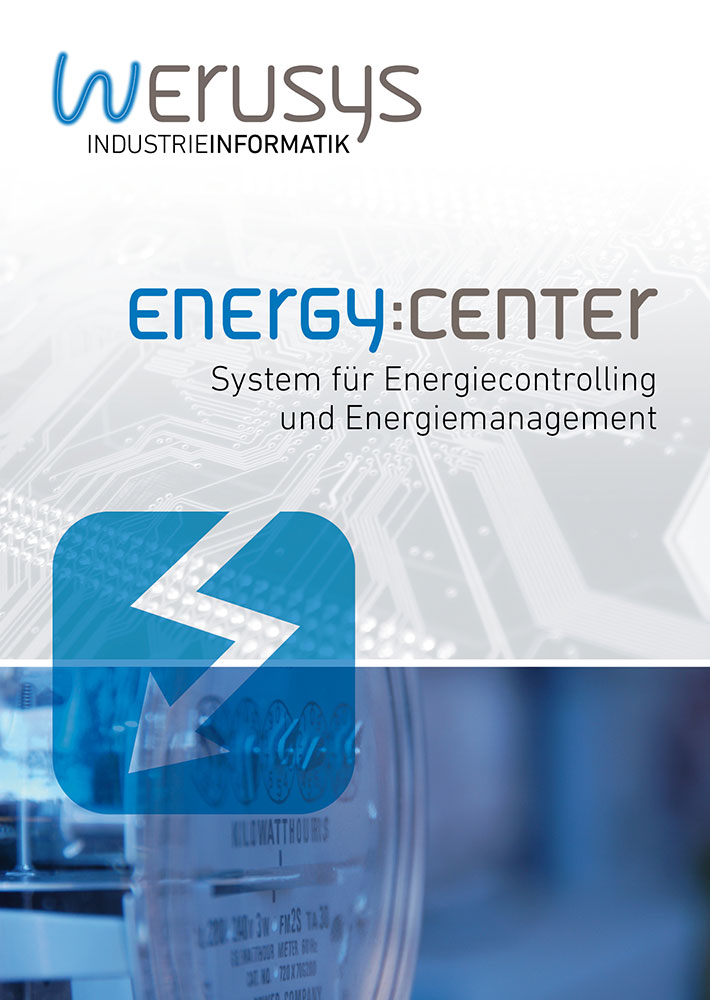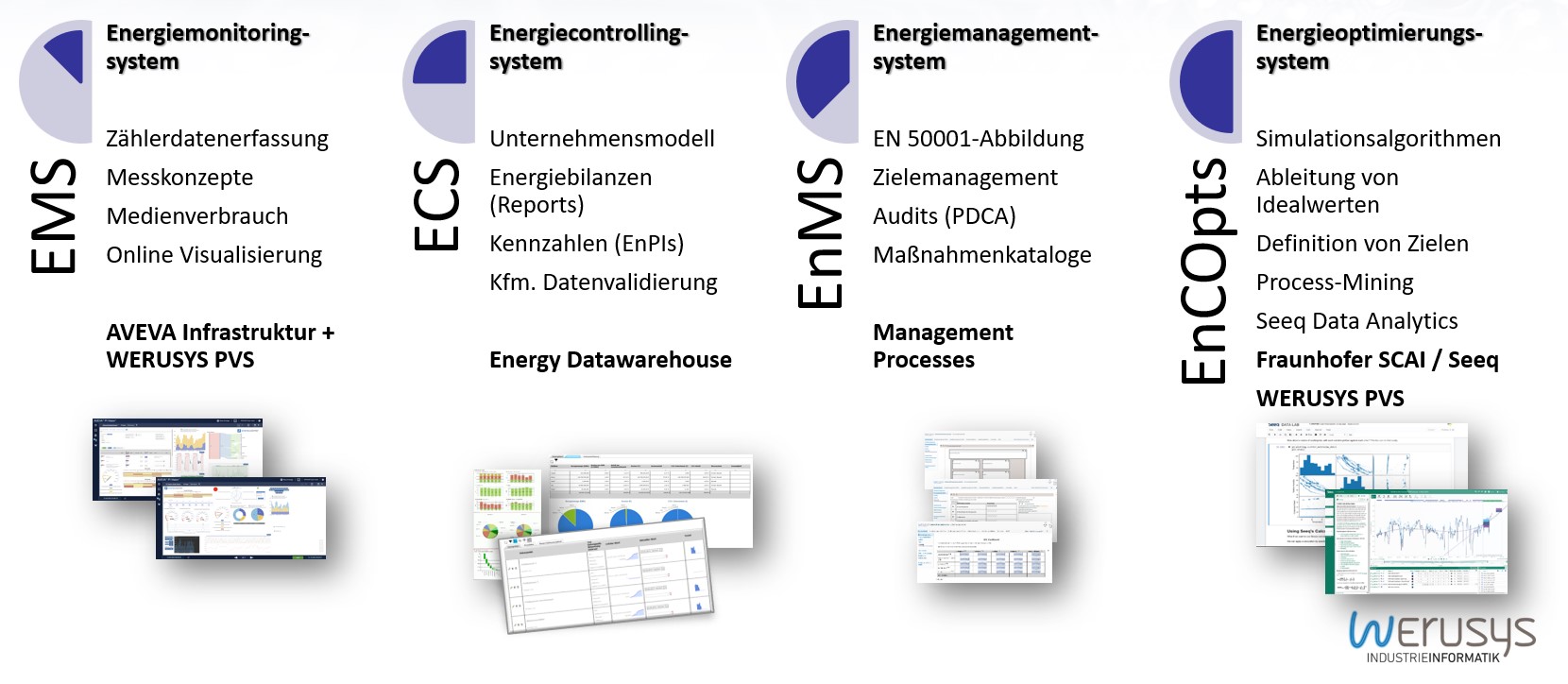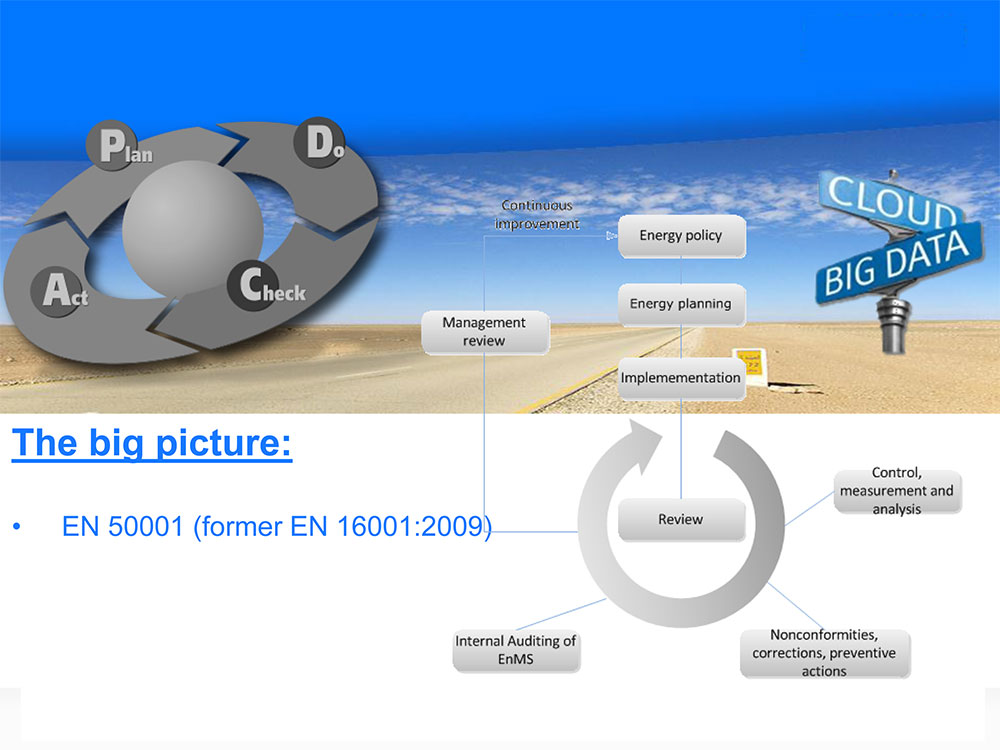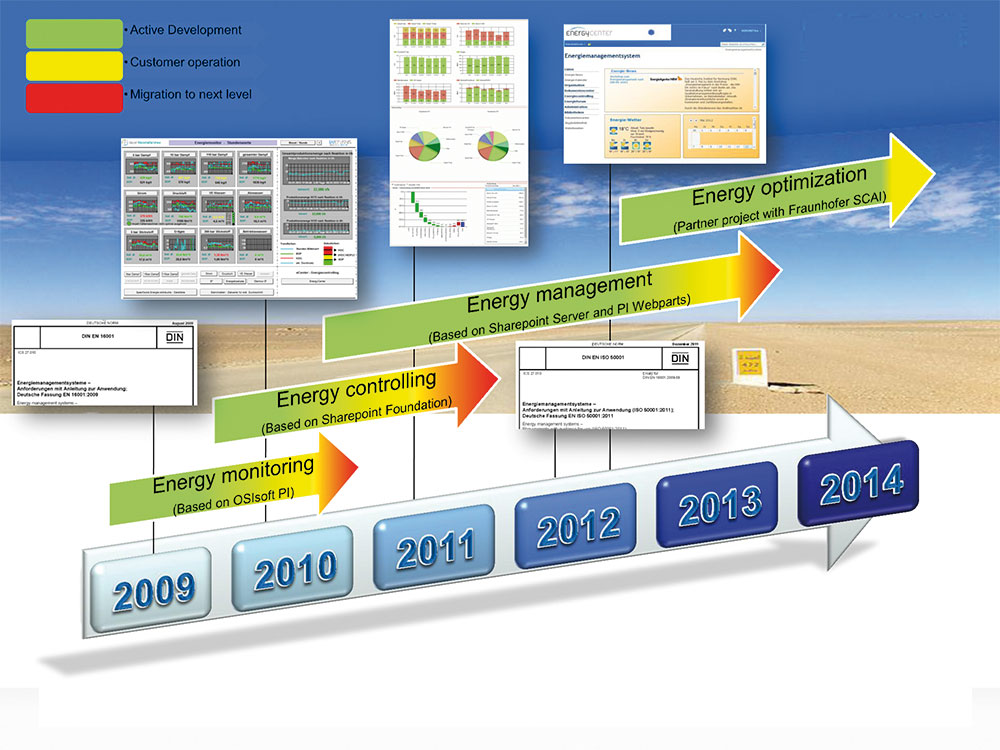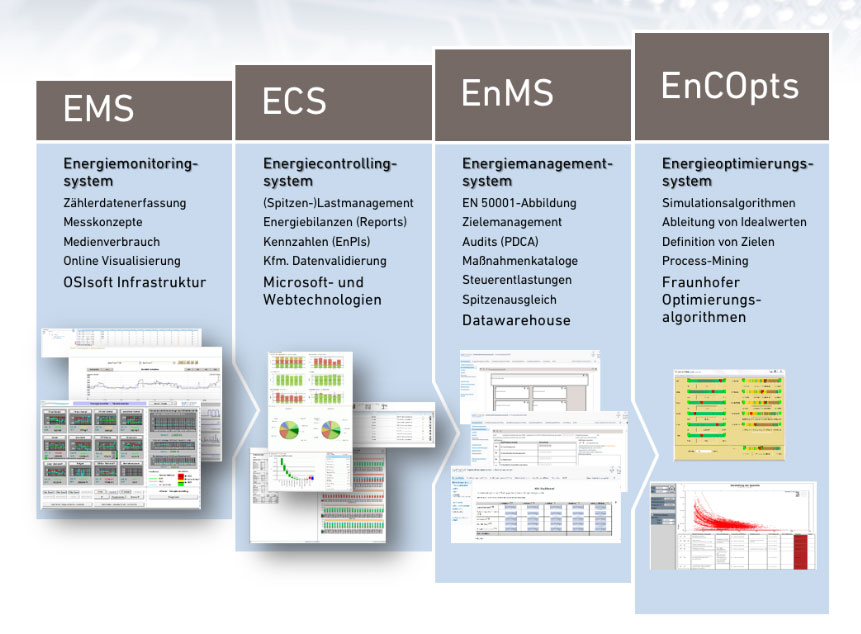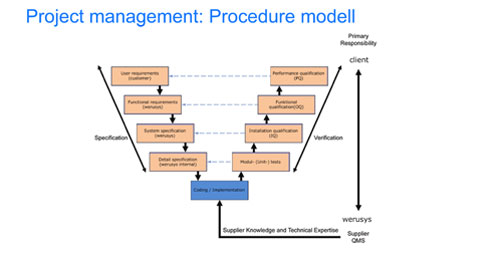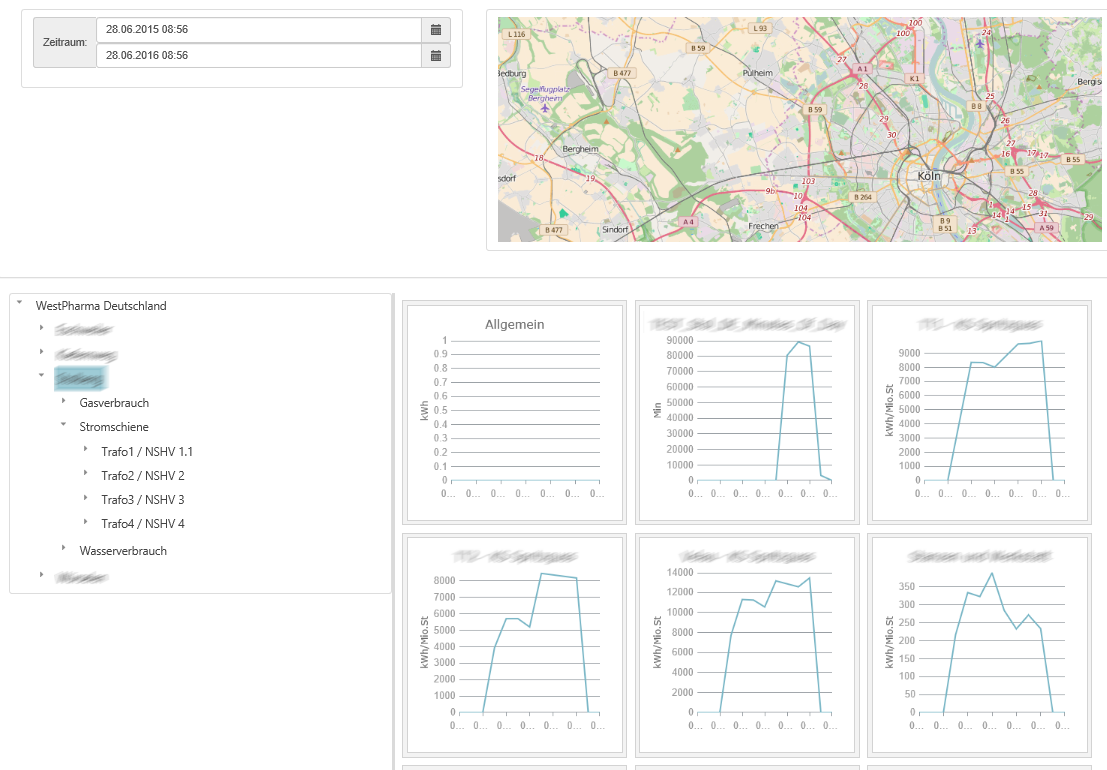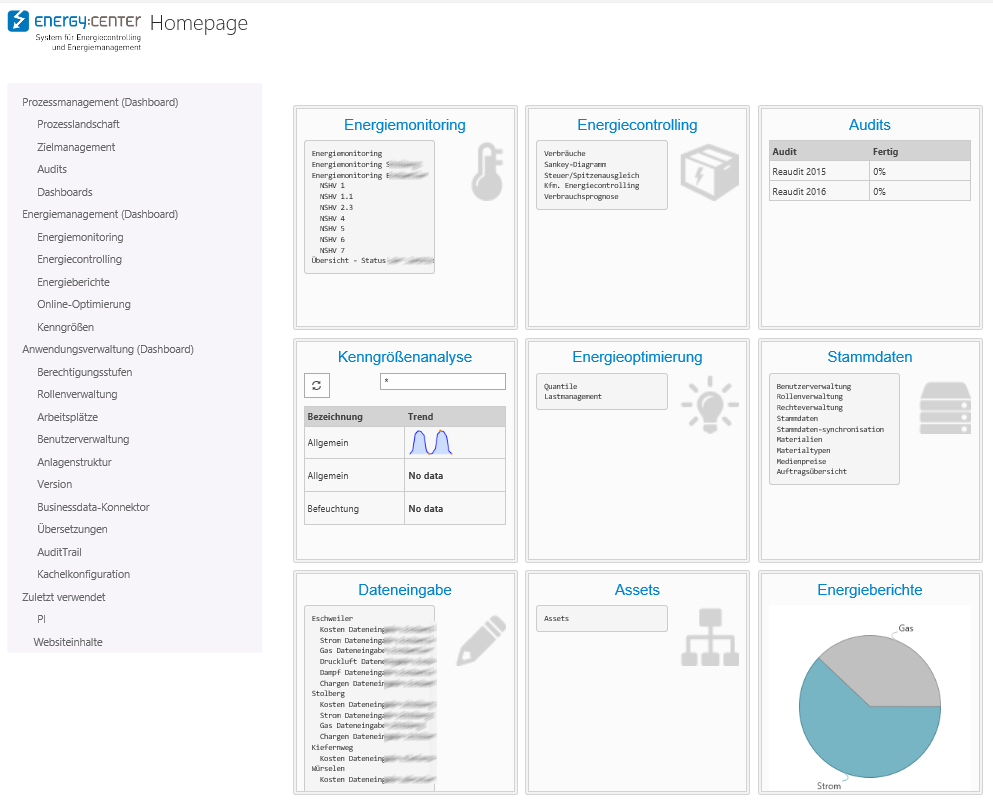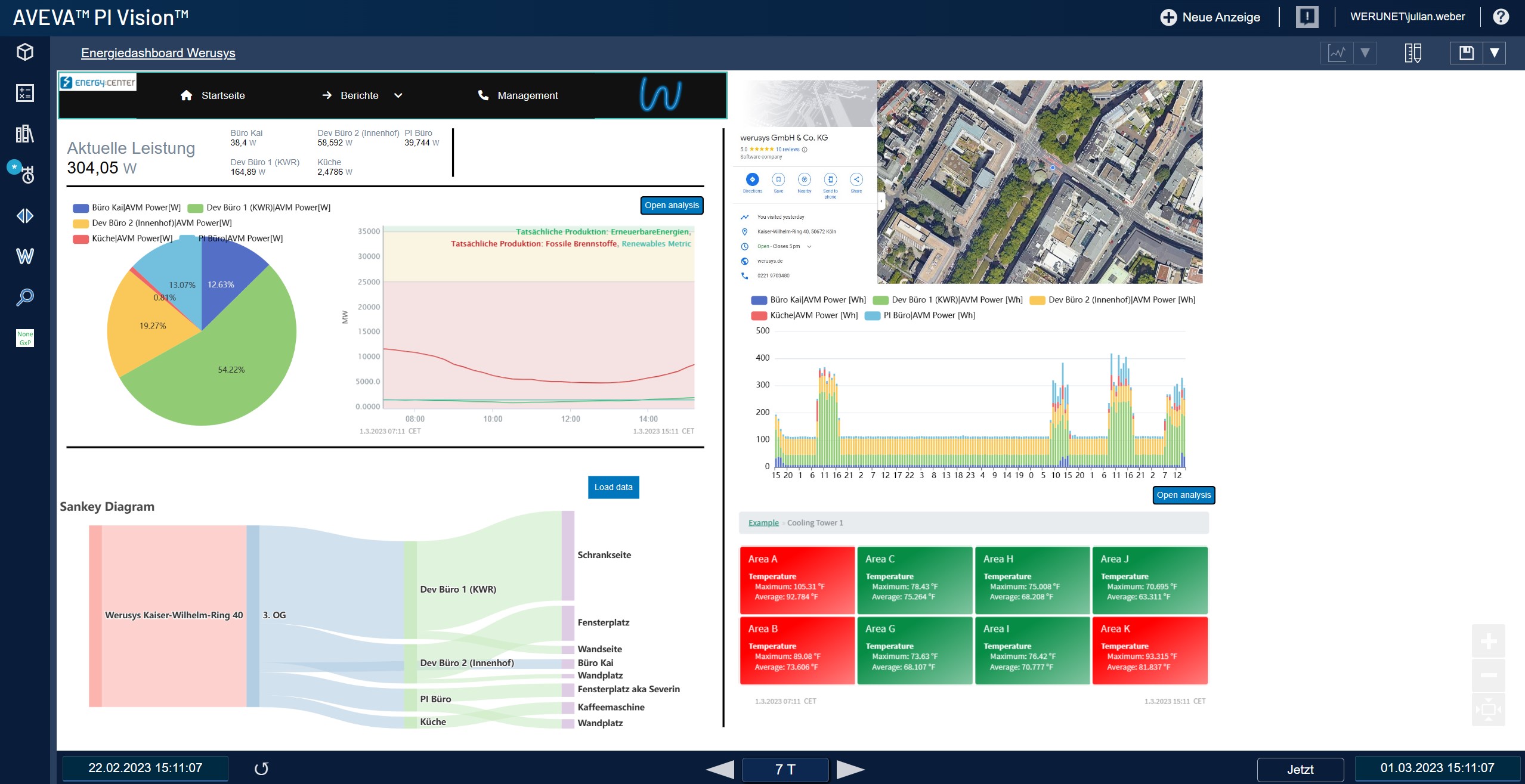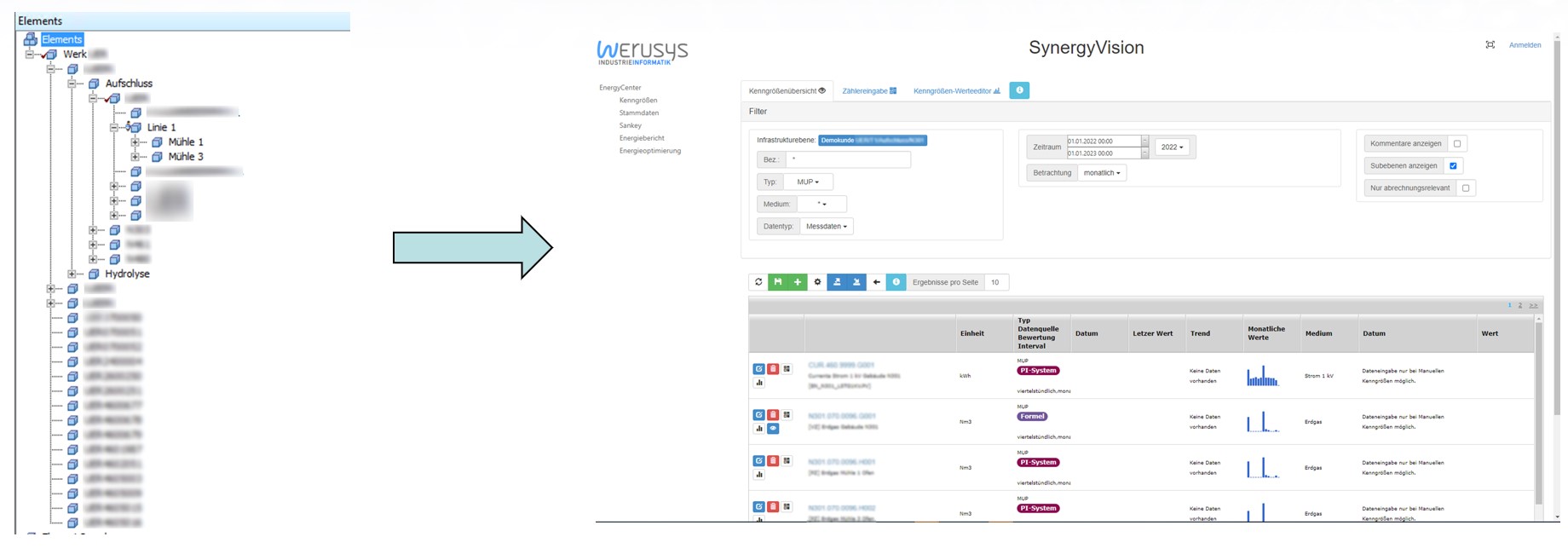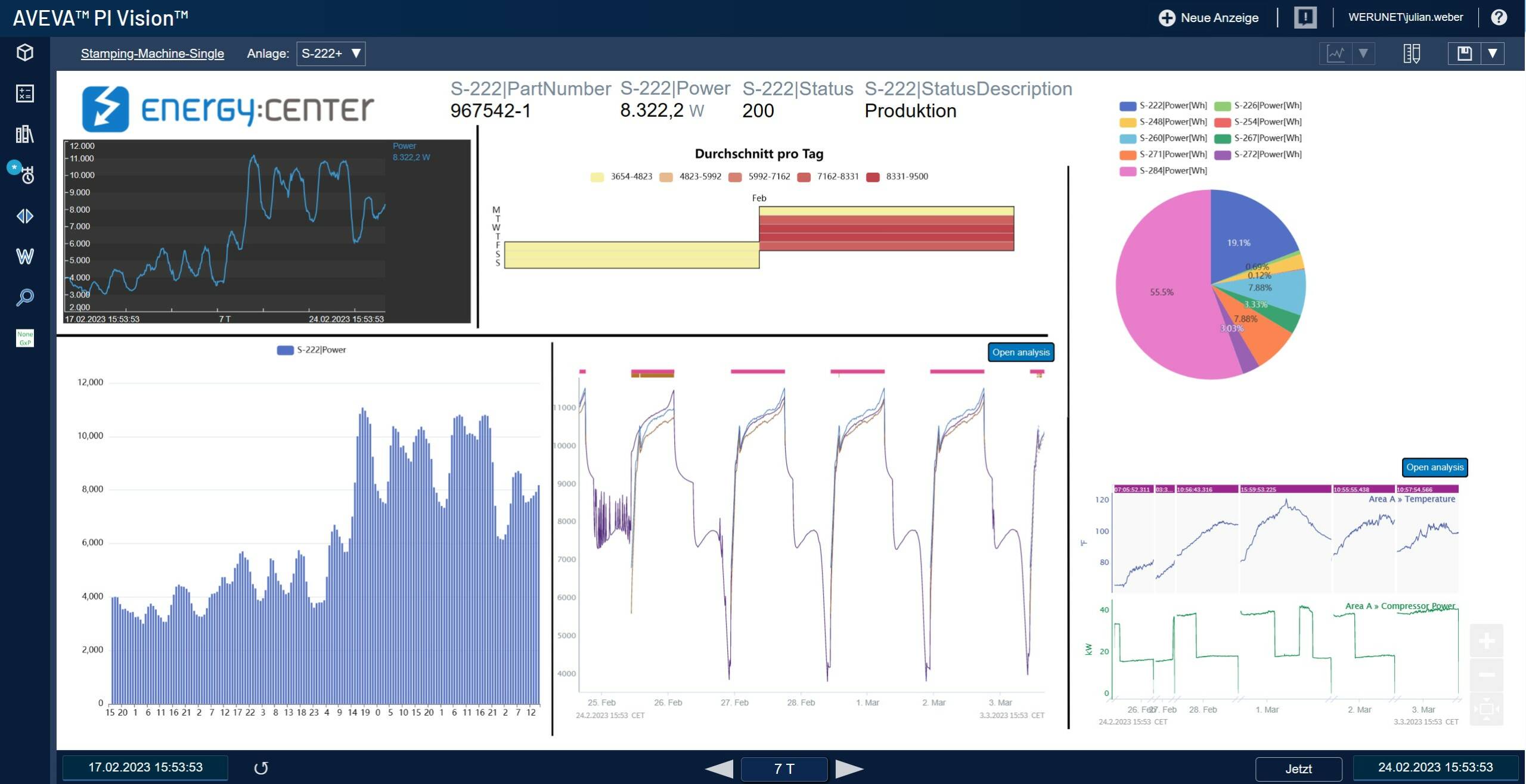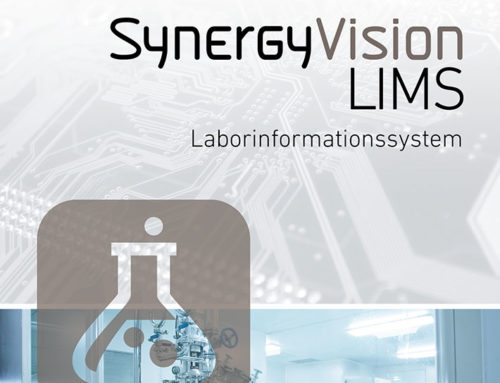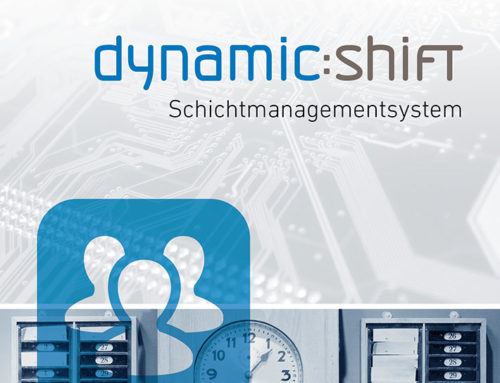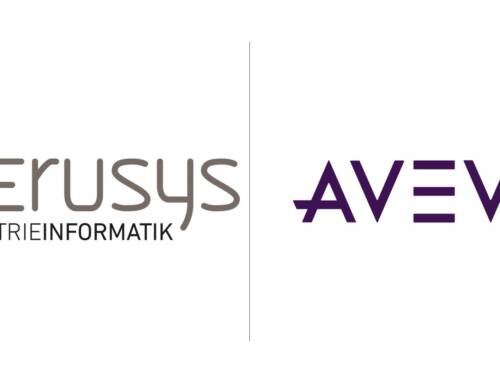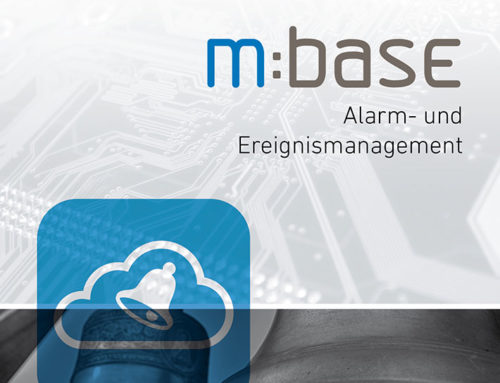energy:center – System für
Energiecontrolling und Energiemanagement
Consultation?
kontakt@werusys.deWrite us!
kontakt@werusys.de
The countdown is on. According to the Energy Services Act (EDL-G), companies with 250 or more employees are obliged to carry out an energy audit. The only way out is to implement or at least order an energy management system (EnMS) according to ISO 50001.
The ISO 50001 standard is valid worldwide and includes measures to increase the energy efficiency of companies. It contains a large number of criteria, the implementation of which can achieve very high energy savings, thus reducing costs and protecting the environment. Certification to this standard is mandatory, for example, if companies want to take advantage of the “peak load compensation under the Energy and Electricity Tax Act” or various subsidy programs. ISO 50001 certification is valid for 3 years. However, it must be verified by annual audits. Werusys Industrieinformatik accompanies you through the entire process and also supports you in the annual audits.
In addition to reducing energy consumption, this can also result in exemption from the EEG surcharge or benefits from the peak tax equalization scheme (SpaEfV). Subsidized energy consulting helps SMEs in all sectors to increase energy efficiency in their operations. This enables them to reduce their energy costs, strengthen their competitiveness and protect the climate. The BMWi supports “energy consulting for SMEs” and covers up to 80 percent of the costs.
Users of the energy:center solution from werusys Industrieinformatik have themselves estimated the savings potential of their EnMS at “several hundred thousand euros per year”, some of which were already realized in the year of introduction.
On a positive note, they emphasize that werusys Industrieinformatik can make the EnMS productively available to the customer in a minimal configuration within six weeks on request.

Sustainable through data utilization
Version 2023.1 of the energy:center is seamlessly integrated into the AVEVA PI system. By expanding the possibilities of PI Vision, detailed and clear energy monitoring is possible. Overall, the Werusys energy:center is divided into four main areas. Energy monitoring, controlling, management and optimization.
Energy prices are rising rapidly. Due to geopolitical tensions and increased global demand for energy, energy prices are rising like never before. Another critical factor is climate change. The need to reduce greenhouse gas emissions and mitigate climate change has led to a shift away from traditional fossil fuels towards renewable energy sources, which has brought with it a period of transition and uncertainty.
The AVEVA PI system can support sustainability initiatives in various ways, e.g:
- Energy management: the PI System can be used to monitor and optimize energy consumption, identify areas of energy waste and reduce greenhouse gas emissions.
- Environmental monitoring: The PI System can collect and analyze data on environmental parameters such as air and water quality, allowing organizations to track their environmental performance and identify opportunities for improvement.
- Sustainability reporting: The PI System can provide the data and analysis needed for sustainability reporting, including greenhouse gas inventories, sustainability metrics and sustainability performance reports.
- Supply chain sustainability: The PI System can track sustainability performance throughout the supply chain, enabling companies to identify and address sustainability risks and opportunities.
- Continuous improvement: The PI System supports a continuous improvement approach to sustainability that enables companies to set targets, track progress and continuously optimize their sustainability performance.
Overall, the AVEVA PI system can play a critical role in supporting sustainability initiatives by enabling companies to collect, store and analyze sustainability data, identify areas for improvement and track progress towards sustainability goals.
The energy crisis is having a significant impact on households, companies and economies around the world. Higher energy prices have driven up the cost of living for many people. The crisis has also highlighted the need for greater investment in energy infrastructure, renewable energy sources and energy efficiency measures to ensure that energy remains affordable and accessible in the long term.
Many of us have years of data in our PI systems waiting to be analyzed in terms of energy consumption and used for optimization. Using data to save energy is important for several reasons:
- Recognizing inefficiencies: Data can be used to identify inefficiencies in energy consumption and production. By analyzing data, companies can identify areas where energy is being wasted or used inefficiently and take action to address these inefficiencies.
- Monitor consumption: Data can be used to monitor energy performance in real time, allowing companies to quickly identify and address issues as they arise.
- Measure progress: Data can be used to measure progress towards energy-saving goals, allowing companies to track their progress over time and make adjustments as needed.
- Optimizing energy use: Data can be used to optimize energy use, such as determining the optimal operating time of appliances or adjusting appliance settings to reduce energy consumption.
- Decision making: Data can be used to make decisions regarding energy consumption and production, allowing companies to make informed decisions that support energy efficiency and sustainability.
The functionality of energy:center includes, among other things:
The Federal Office of Economics and Export Control (BAFA) has added the synergy:vision energy management module to its “list of eligible energy management software”. This means that the werusys EnMS is one of only 77 systems at this time that are classified as “eligible for funding in accordance with the Federal Ministry of Economics and Technology’s directive on the funding of energy management systems dated July 22, 2013”.
The total amount of funding can amount to a maximum of 20,000 euros per company within a period of 36 months.
Intuitive operating concept
Asset Browser Preview
The PI System and energy management
The PI System can support sustainability initiatives in several ways, including:
- Energy management: The PI System can be used to monitor and optimize energy usage, identify areas of energy waste, and reduce greenhouse gas emissions.
- Environmental monitoring: The PI System can collect and analyze data on environmental parameters such as air and water quality, enabling organizations to track environmental performance and identify opportunities for improvement.
- Sustainability reporting: The PI System can provide the data and analytics needed for sustainability reporting, including greenhouse gas inventories, sustainability metrics, and sustainability performance reports.
- Supply chain sustainability: The PI System can be used to track sustainability performance throughout the supply chain, enabling organizations to identify and address sustainability risks and opportunities.
- Continuous improvement: The PI System supports a continuous improvement approach to sustainability, enabling organizations to set goals, track progress, and continually optimize their sustainability performance.
Overall, the AVEVA PI System can play a critical role in supporting sustainability initiatives by enabling organizations to collect, store, and analyze sustainability data, identify areas for improvement, and track progress towards sustainability goals.
Automatic master data synchronization PI System – energy:center
With the help of automatic master data synchronization, all data and plant structures from the PI system are automatically transferred to the energy:center. This means that all existing data can be seamlessly integrated into the energy management system. Further calculations are now made within the energy:center and used in energy controlling and energy management. This enables the system to manage energy targets, cost centers, energy suppliers and prices (optional connection to energy exchanges) in direct connection with all existing PI data.
Energy monitoring
Energy monitoring is a key element of an energy management system (EnMS) as defined in the ISO 50001 standard, which requires organizations to develop a systematic approach to energy management, including the use of data and information to support decision making and continuous improvement.
Specifically, the ISO 50001 standard requires organizations to establish energy baselines and performance indicators, and to collect and analyze data on energy consumption and performance. This data should be used to identify areas for improvement, set energy performance targets, and track progress toward those targets.
Energy monitoring enables organizations to:
- Collect data on energy use and performance: this data can be used to set baselines and targets, and to track progress toward energy performance goals.
- Identify areas for improvement: Energy monitoring can help organizations identify areas where energy is wasted and where energy efficiency can be improved.
- Measure and verify savings: Energy monitoring allows companies to accurately measure and verify energy savings achieved through energy efficiency improvements.
- Optimizing energy use: by monitoring energy use in real time, companies can optimize their energy use by, for example, adjusting the settings of their equipment or shifting energy-intensive activities to off-peak times.
Energy monitoring an important component of an EnMS in accordance with the ISO 50001 standard, as it enables organizations to develop a systematic approach to energy management, track progress toward energy savings targets, and continuously improve their energy performance.
PI Vision for energy monitoring
PI Vision is a visualization tool provided by the PI System that can be used to support energy management initiatives by providing an intuitive, user-friendly interface for energy data visualization and analysis. Here are a few ways PI Vision can help with energy monitoring and energy management:
- Real-time monitoring: PI Vision can be used to create custom dashboards that display real-time data on energy consumption and performance, enabling organizations to monitor energy usage in real-time and identify opportunities for optimization.
- Visualization: PI Vision provides a range of data visualization tools, such as charts, graphs, and heat maps, that enable organizations to gain insights into energy usage patterns and trends, and to identify areas for improvement.
- Analysis: PI Vision includes advanced analytical capabilities that enable organizations to perform complex calculations and statistical analyses on energy data, such as identifying correlations between energy usage and production output.
- Reporting: PI Vision can be used to create custom reports on energy consumption and performance, providing stakeholders with clear and concise information on energy usage and performance.
- Energy optimization: By providing real-time data and analytics, PI Vision can be used to optimize energy usage, such as adjusting equipment settings or optimizing production schedules.
- Measurement and verification: PI Vision can be used to accurately measure and verify the energy savings achieved through energy management initiatives, providing organizations with the data they need to demonstrate the financial and environmental benefits of their efforts.
PI Vision is a powerful tool for energy monitoring and energy management, providing organizations with the data visualization, analysis, and reporting capabilities they need to optimize energy usage, reduce waste, and achieve their energy reduction goals.
ISO50001 Energiemanagement
ISO 50001 is an internationally recognized standard that provides a framework for implementing an energy management system (EnMS) in an organization. The standard was first published in 2011 and updated in 2018.
The purpose of ISO 50001 is to help organizations establish systems and processes that enable them to improve energy efficiency, reduce energy consumption, and minimize greenhouse gas emissions. By implementing an EnMS in accordance with the ISO 50001 standard, organizations can identify areas of energy waste, set goals for improving energy performance, and systematically monitor and measure their progress toward achieving those goals.
ISO 50001 is based on the “Plan-Do-Check-Act” (PDCA) cycle, a widely used management model for continuous improvement. The standard provides a systematic approach to energy management and can be integrated with other management systems such as ISO 9001 (quality management) and ISO 14001 (environmental management).
Organizations that implement an EnMS in accordance with the ISO 50001 standard can benefit from lower energy costs, improved operational efficiency, and enhanced reputation and credibility with customers, suppliers, and other stakeholders. In addition, the standard can help organizations comply with energy-related regulations and laws, and it can support their efforts to achieve sustainability and carbon reduction goals.
ISO 50001 is applicable to organizations of all sizes and industries and can be implemented anywhere in the world. The standard is voluntary, but many organizations choose to implement it to demonstrate their commitment to energy management and sustainability.

